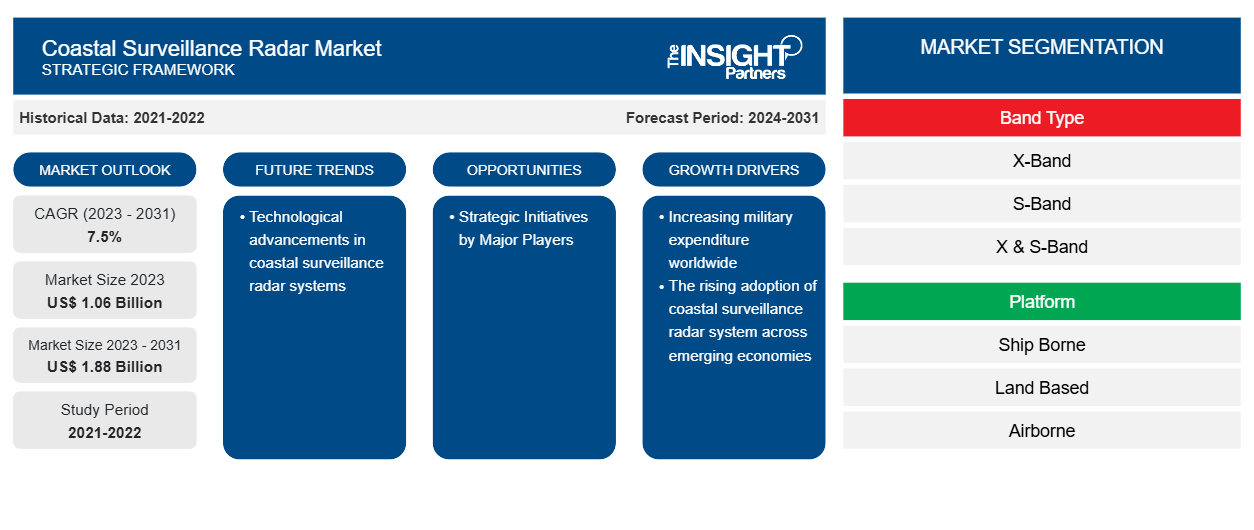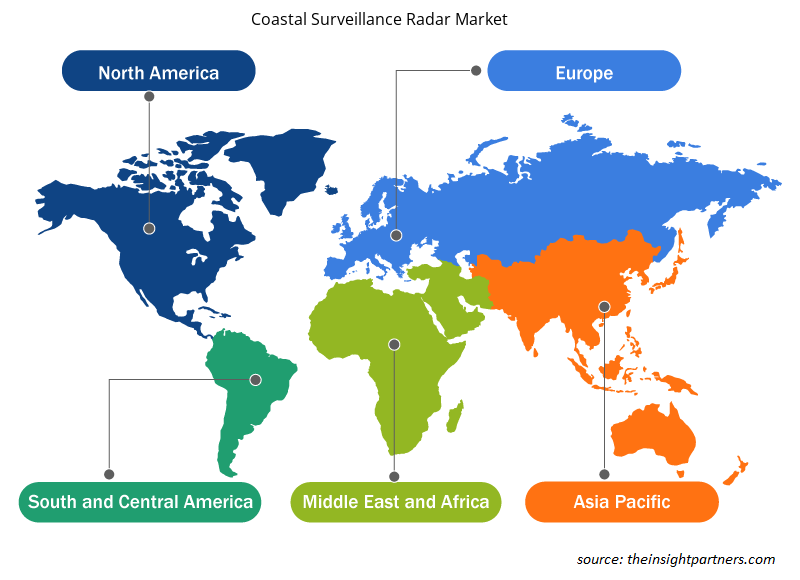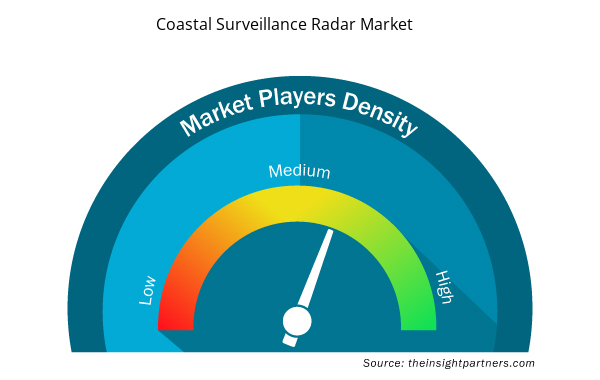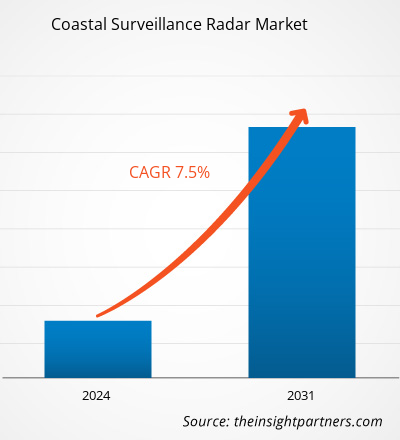The coastal surveillance radar market size is projected to reach US$ 1.88 billion by 2031 from US$ 1.06 billion in 2023. The market is expected to register a CAGR of 7.5% during 2023–2031. Technological advancements in coastal surveillance radar systems are likely to remain a key trend in the market.
Coastal Surveillance Radar Market Analysis
Elbit Systems Ltd, Thales Group, Israel Aerospace Industries, Hensoldt AG, and Terma A/S, are some of the key market players operating in the global coastal surveillance radar market. These companies engage themselves in developing robust systems including X-band, S-band, and X and S-band radars for various end users. In addition, these companies also enjoy substantial numbers of contracts for their radars from various naval forces, coast guards, oil & gas companies, as well as ports. The companies sign long-term agreements with the end users to support the supply of coastal surveillance radar products, which enables the companies to generate revenue year on year.
Coastal Surveillance Radar Market Overview
The major stakeholders in the global coastal surveillance radar market ecosystem include component manufacturers, system integrators, and end-users amongst others. A coastal surveillance system radar is made up of various components which are procured by the system manufacturers from a huge base of component manufacturers. These component manufacturers supply the base parts to the global coastal surveillance radar players. The system integrators are the companies that are engaged in manufacturing the final surveillance radar systems after integrating each component. The end-user of the global coastal surveillance radar market include both governing bodies and private organizations that are carrying out business across the coastline. The on-shore multinational oil and gas companies that are on the coastlines are highly dependent on surveillance radars to ensure safety and security in their operation and of their assets. On the other hand, the rise in military expenditure by developed and developing nations and their rising investments to sure both land and coastal borders from factors like drug trafficking, terror, and undocumented immigrants amongst others is also propelling the high adoption of coastal surveillance radar by the government bodies.
Customize This Report To Suit Your Requirement
You will get customization on any report - free of charge - including parts of this report, or country-level analysis, Excel Data pack, as well as avail great offers and discounts for start-ups & universities
Coastal Surveillance Radar Market: Strategic Insights

- Get Top Key Market Trends of this report.This FREE sample will include data analysis, ranging from market trends to estimates and forecasts.
You will get customization on any report - free of charge - including parts of this report, or country-level analysis, Excel Data pack, as well as avail great offers and discounts for start-ups & universities
Coastal Surveillance Radar Market: Strategic Insights

- Get Top Key Market Trends of this report.This FREE sample will include data analysis, ranging from market trends to estimates and forecasts.
Coastal Surveillance Radar Market Drivers and Opportunities
Rising Adoption of Coastal Surveillance Radar System Across Emerging Economies
The rise in border threats across emerging economies such as China, India, Taiwan, South Korea, Russia, Ukraine, Israel, Palestine, and Iran is expected to boost the adoption of coastal surveillance radar systems. Owing to the rise in marine warfare and oceanic insurgencies, coastal regions across these economies are becoming increasingly vital, and surveillance radar plays a crucial role in detecting threats in real time. Commanders can get valuable insights into enemy movements and their surroundings by deploying advanced radar systems along coastal boundaries, thereby taking necessary measures based on real-time data. This benefit of gathering real-time data with clear and high-resolution images is the crucial attraction point for the end users. Hence, on the back of the crucial parameters, the coastal surveillance radar market has been growing across the world.
Strategic Initiatives by Major Players
The companies operating in the coastal surveillance radar market are adopting organic and inorganic growth strategies, such as high investments, product offerings, and global expansion, further creating growth opportunities for the global coastal surveillance radar market. A few key developments to be mentioned are:
- In September 2022, the US Coast Guard awarded a contract to L3Harris Technologies Inc for up to five AN/APY-11 multimode radars that will be installed on new C-130J Super Hercules long range surveillance aircraft during the Minotaur missionization process. The firm fixed price contract is for the delivery of three multimode radars, which will be installed by L-3 Communication Integrated Systems in Waco, Texas, during the missionization and Block 8.1 upgrade for the 18th, 19th and 20th C-130J aircraft in the Coast Guard fleet.
- In December 2022, LIG Nex1 Co signed an agreement with the Naval Logistics Command for the Maritime Surveillance Radar-II project.
Such developments heve been generating new opportunities for market vendors across different regions.
Coastal Surveillance Radar Market Report Segmentation Analysis
Key segments that contributed to the derivation of the coastal surveillance radar market analysis are band type, platform, and end user.
- Based on band type, the coastal surveillance radar market is segmented into X-band, S-band, X/S-band, and others. The X-band segment held a larger market share in 2023.
- Based on the platform, the coastal surveillance radar market is segmented into shipborne, land based, and airborne. The airborne segment held a larger market share in 2023.
- Based on end user, the coastal surveillance radar market is segmented into ports harbor oil & gas companies and maritime patrol agencies. The maritime patrol agencies segment held a larger market share in 2023.
Coastal Surveillance Radar Market Share Analysis by Geography
The geographic scope of the coastal surveillance radar market report is mainly divided into five regions: North America, Europe, Asia Pacific, Middle East & Africa, and South America.
North America has dominated the market in 2023 followed by Europe and Asia Pacific regions. Further, Asia Pacific is also likely to witness highest CAGR in the coming years. The US accounted for the largest market share in North America coastal surveillance radar market. The US is also a technologically advanced country and has a huge potential to adopt new technologies over the years. The oil and gas companies present across the country also have huge potential to adopt technologies for securing their operation across the coastlines. This is further influencing the adoption of coastal surveillance radars to limit or restrict illicit activities across the country. Accipiter Radar Technologies Inc, Teledyne FLIR LLC, L3Harris Technologies Inc, Raytheon Technologies Corporation, and SSR Engineering are some of the players operating in the US market.
Coastal Surveillance Radar Market Regional Insights
The regional trends and factors influencing the Coastal Surveillance Radar Market throughout the forecast period have been thoroughly explained by the analysts at Insight Partners. This section also discusses Coastal Surveillance Radar Market segments and geography across North America, Europe, Asia Pacific, Middle East and Africa, and South and Central America.

- Get the Regional Specific Data for Coastal Surveillance Radar Market
Coastal Surveillance Radar Market Report Scope
| Report Attribute | Details |
|---|---|
| Market size in 2023 | US$ 1.06 Billion |
| Market Size by 2031 | US$ 1.88 Billion |
| Global CAGR (2023 - 2031) | 7.5% |
| Historical Data | 2021-2022 |
| Forecast period | 2024-2031 |
| Segments Covered |
By Band Type
|
| Regions and Countries Covered | North America
|
| Market leaders and key company profiles |
Coastal Surveillance Radar Market Players Density: Understanding Its Impact on Business Dynamics
The Coastal Surveillance Radar Market is growing rapidly, driven by increasing end-user demand due to factors such as evolving consumer preferences, technological advancements, and greater awareness of the product's benefits. As demand rises, businesses are expanding their offerings, innovating to meet consumer needs, and capitalizing on emerging trends, which further fuels market growth.
Market players density refers to the distribution of firms or companies operating within a particular market or industry. It indicates how many competitors (market players) are present in a given market space relative to its size or total market value.
Major Companies operating in the Coastal Surveillance Radar Market are:
- Accipiter Radar Technologies Inc
- Aselsan AS
- Blighter Surveillance Systems Ltd
- Easat Radar Systems Ltd
- Elbit Systems Ltd
- Teledyne FLIR LLC
Disclaimer: The companies listed above are not ranked in any particular order.

- Get the Coastal Surveillance Radar Market top key players overview
Coastal Surveillance Radar Market News and Recent Developments
The coastal surveillance radar market is evaluated by gathering qualitative and quantitative data post primary and secondary research, which includes important corporate publications, association data, and databases. A few of the developments in the coastal surveillance radar market are listed below:
- Leonardo has acquired a 30% stake of share capital in GEM elettronica, an Italian company specialising in the production of small and medium-sized 3D radars, electro-optical sensors and inertial systems for the maritime, air and land sectors. (Source: Leonardo, Press Release, Apr 2021)
- Sensor solutions provider HENSOLDT is equipping the US Coast Guard’s “Legend” class National Security Cutter (NSC) with its proven TRS-3D multi-mode naval radar. The US Coast Guard awarded HENSOLDT a follow-on contract worth approximately 10 Mio. $ to deliver a further radar in its latest ‘Baseline D’ version to be installed at the Coast Guard training center (TRACEN), Petaluma/CA. Up to now, HENSOLDT has delivered 12 radars to the US Coast Guard’s NSC program. (Source: HENSOLDT, Press Release, Sep 2023)
Coastal Surveillance Radar Market Report Coverage and Deliverables
The “Coastal Surveillance Radar Market Size and Forecast (2021–2031)” report provides a detailed analysis of the market covering below areas:
- Coastal surveillance radar market size and forecast at global, regional, and country levels for all the key market segments covered under the scope
- Coastal surveillance radar market trends as well as market dynamics such as drivers, restraints, and key opportunities
- Detailed porter’s five forces analysis
- Coastal surveillance radar market analysis covering key market trends, global and regional framework, major players, regulations, and recent market developments
- Industry landscape and competition analysis covering market concentration, heat map analysis, prominent players, and recent developments for the coastal surveillance radar market
- Detailed company profiles
- Historical Analysis (2 Years), Base Year, Forecast (7 Years) with CAGR
- PEST and SWOT Analysis
- Market Size Value / Volume - Global, Regional, Country
- Industry and Competitive Landscape
- Excel Dataset



Report Coverage
Revenue forecast, Company Analysis, Industry landscape, Growth factors, and Trends

Segment Covered
Band Type, Platform, and End User

Regional Scope
North America, Europe, Asia Pacific, Middle East & Africa, South & Central America

Country Scope
Australia, Brazil, Canada, China, France, Germany, India, Italy, Japan, Mexico, Russian Federation, Saudi Arabia, South Africa, South Korea, United Arab Emirates, United Kingdom, United States
Frequently Asked Questions
Which region dominated the coastal surveillance radar market in 2023?
North America region dominated the coastal surveillance radar market in 2023.
What are the driving factors impacting the coastal surveillance radar market ?
Increasing military expenditure worldwide and rising adoption of coastal surveillance radar system across emerging economies are some of the factors driving the growth for coastal surveillance radar market.
What are the future trends of the coastal surveillance radar market ?
Technological advancements in coastal surveillance radar systems is one of the major trends of the market.
Which are the leading players operating in the coastal surveillance radar market ?
Accipiter Radar Technologies Inc, Aselsan AS, Blighter Surveillance Systems Ltd, Easat Radar Systems Ltd, Elbit Systems Ltd, Teledyne FLIR LLC, GEM Electronica, HENSOLDT AG, Israel Aerospace Industries, L3Harris Technologies Inc, Raytheon Technologies Corporation, Terma A/S, Thales Group, Havelsan AS, Mskyeye Co Ltd, Advanced Radar Technologies (ART), and TOKYO KEIKI INC are some of the key players profiled under the report.
What would be the estimated value of the coastal surveillance radar market by 2031?
The estimated value of the coastal surveillance radar market by 2031 would be around US$ 1.88 billion.
What is the expected CAGR of the coastal surveillance radar market ?
The coastal surveillance radar market is likely to register of 7.5% during 2023-2031.

 Get Free Sample For
Get Free Sample For